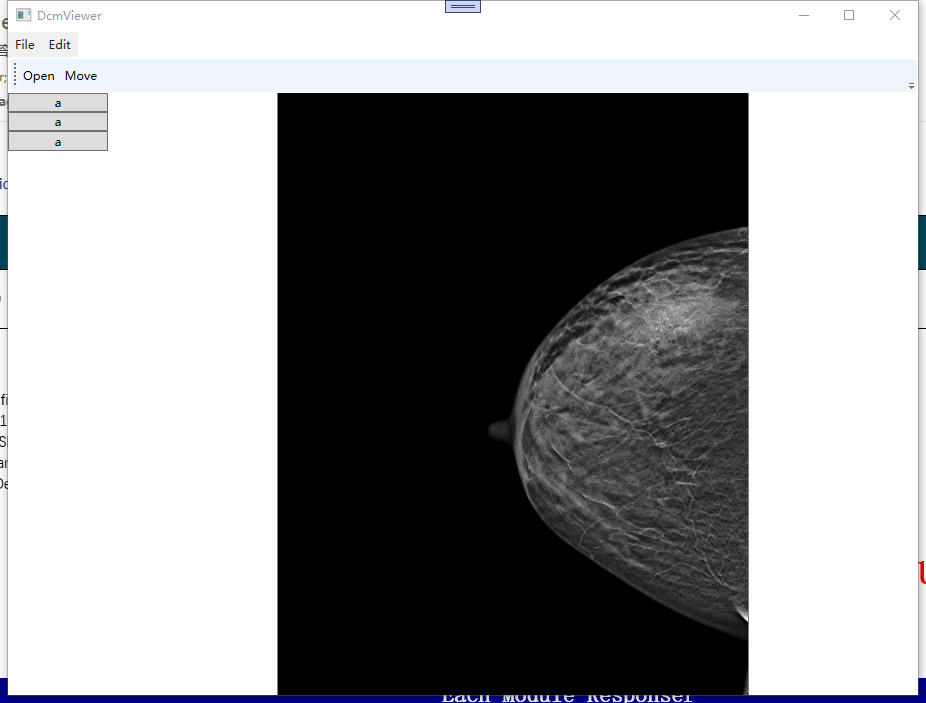实现一个DICOM浏览工具——显示图像
在通过fo-dicom解析图像后,需要把图像显示到窗体中,在xaml中添加Image控件,命名为 DcmImage。
public async Task OpenAsync(string filename)
{
var file = await DicomFile.OpenAsync(filename);
if (file.Dataset.Contains(DicomTag.PixelData))
{
var dicomImage = new DicomImage(file.Dataset);
// fo-dicom中默认是用WinFormImageManager进行图像管理的,如果想在wpf中使用,需要指定为WpfImageManager类
// 之所以要在这里指定ImageMnager,是因为在DicomImage的RenderImage方法中会调用ImageManager实现类的CreateImageImpl方法获取相对应的图像数据
ImageManager.SetImplementation(ViewerImageManager.Instance);
var frames = Enumerable.Range(0, dicomImage.NumberOfFrames)
.Select(frame => dicomImage.RenderImage(frame).As<ImageSource>())
.ToList();
if (frames.Count > 0)
{
DcmImage.Source = frames[0];
}
}
}
在fo-dicom源码中包含了WPFImageManager,但是我通过nuget安装后的找不到这个类,不知道为什么,后边没办法,只能参考github上边的自己写了一个ImageManager类,用来做图像处理的管理工具,具体代码如下:
namespace DcmViewer
{
using Dicom.Imaging;
public sealed class ViewerImageManager : ImageManager
{
#region FIELDS
public static readonly ImageManager Instance;
#endregion
#region CONSTRUCTORS
static ViewerImageManager()
{
Instance = new ViewerImageManager();
}
#endregion
#region PROPERTIES
public override bool IsDefault {
get
{
return false;
}
}
#endregion
#region METHODS
protected override IImage CreateImageImpl(int width, int height)
{
return new ViewerImage(width, height);
}
#endregion
}
}
上边的ViewerImageManager还缺少一个对应的ViewerImage类,代码如下:
namespace DcmViewer
{
public sealed class ViewerImage : ImageBase<WriteableBitmap>
{
#region FIELDS
private const double DPI = 96;
#endregion
#region CONSTRUCTORS
public ViewerImage(int width, int height): base(width, height, new Dicom.IO.PinnedIntArray(width * height), null)
{
}
private ViewerImage(int widht, int height, PinnedIntArray pixels, WriteableBitmap image) : base(widht, height, pixels, image)
{
}
#endregion
#region METHODS
public override void Render(int components, bool flipX, bool flipY, int rotation)
{
var bitmap = CreateBitMap(width, height, components, pixels.Data);
image = ApplyFlipRotate(bitmap, flipX, flipY, rotation);
}
public override void DrawGraphics(IEnumerable<IGraphic> graphics)
{
foreach (var graphic in graphics)
{
var layer = graphic.RenderImage(null).As<WriteableBitmap>();
var overlay = new int[graphic.ScaledWidth * graphic.ScaledHeight];
var stride = 4 * graphic.ScaledWidth;
layer.CopyPixels(overlay, stride, 0);
image.WritePixels(
new Int32Rect(
graphic.ScaledOffsetX,
graphic.ScaledOffsetY,
graphic.ScaledWidth,
graphic.ScaledHeight),
overlay,
stride,
0);
}
}
public override IImage Clone()
{
return new ViewerImage(
width,
height,
new PinnedIntArray(pixels.Data),
image == null ? null : new WriteableBitmap(image));
}
private static WriteableBitmap CreateBitMap(int width, int height, int components, int[] pixelData)
{
var format = components == 4 ? PixelFormats.Bgra32 : PixelFormats.Bgr32;
var bitmap = new WriteableBitmap(width, height, DPI, DPI, format, null);
bitmap.Lock();
Marshal.Copy(pixelData, 0, bitmap.BackBuffer, pixelData.Length);
bitmap.AddDirtyRect(new Int32Rect(0, 0, width, height));
bitmap.Unlock();
return bitmap;
}
private static WriteableBitmap ApplyFlipRotate(WriteableBitmap bitmap, bool flipX, bool flipY, int rotation)
{
if (rotation == 0 && !flipX && !flipY)
{
return bitmap;
}
var rotFlipTransform = new TransformGroup();
rotFlipTransform.Children.Add(new RotateTransform(rotation));
rotFlipTransform.Children.Add(new ScaleTransform(flipX ? -1 : 1, flipY ? -1 : 1));
return new WriteableBitmap(new TransformedBitmap(bitmap, rotFlipTransform));
}
#endregion
}
}
在实现类OpenButton的响应函数后,实现初步的简单显示效果如下:
